Yes PEMF therapy is safe in general, however there are certain ranges of pulsing electro-magnetic fields which you may wish to avoid as we will show below.
Most importantly we should check for information from the FDA and consider the international guidelines for electro-magnetic field exposure, but otherwise:
- Pulsed electromagnetic fields are non-ionizing and therefore produce no tissue heating concerns
- Any reported side-effects are typically mild and transient (like localized warmth or dizziness)
- Contra-indications reflect other electromagnetic devices: keep the coils away from pacemakers and any other electronic implants (ie. pacemakers) and monitor for implant heating when using very high field strengths
We will also take a closer look at high intensity PEMF which if you have further curiosity check our full page on the topic, High Intensity PEMF.
Table Of Contents
On this page
Is PEMF FDA Approved?
There is no such thing as a blanket approval from the FDA for PEMF devices, however some devices have been registered and cleared for sale using the FDA’s 510(K) pre-market authorization form, and others are considered either Class 1 or 2, low risk devices and qualify for exemption.
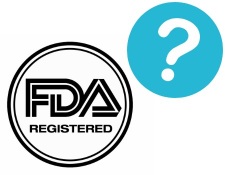
The 510(K) form is used to determine if a product is similar enough to an already existing product such that they can verify the new product is safe without further testing. This is not the same as an FDA “approval” but it does still mean the FDA considers the product safe for the public.
The case with most PEMF mats currently is an exemption via their Class 1 or 2 status, meaning they’re considered low-risk devices and don’t need further review.
You can actually search the FDA’s database of 510(K) forms to see if a device has approval, although sometimes a device may be registered under a different name than they are marketed, FDA 510(K) Database.
Fun fact: the first PEMF device was cleared by the FDA for helping bone fractures all the way back in 1979.
Does PEMF Have Any Side Effects
The short answer is: no PEMF therapy doesn’t have any side effects when used correctly.
There are some minor side effects which could occur and they’re very dependent on the individual and the PEMF itself as I’ll illustrate with my own adverse experience story.
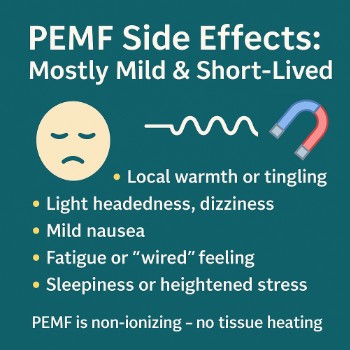
Some common “adverse events” which could occur are:
- local warmth or tingling
- light headedness, dizziness
- mild nausea
- fatigue or “wired” feeling
A couple other common sensations are sleepiness and heightened stress, but those are more PEMF frequency dependent (very low frequency, or very high) and usually only when your head is within the pulsing magnetic field.
Otherwise all the listed symptoms/events above will be transient and pass fairly quickly, within minutes or an hour or two.
There are things to avoid and individuals who should avoid PEMF therapy, I’m going to give you everything I know on that presently as well but first I’ll tell you about my own adverse experience.
My Own Adverse Experience
Everyone experiences PEMF differently, someone may even say that they “feel” the PEMF while most people don’t feel a thing.
I’ve even come across someone who can accurately tell whether or not you turn up or down the PEMF frequency on the controller when they’re on a PEMF mat.
For myself, I learned that I’m not a fan of the higher PEMF frequencies.
This was upon one occasion which I used a 30Hz setting in frequency on my mat in the morning to help wake up, which it does help, using a higher frequency in the morning – what I didn’t expect was to have my mind running at full tilt afterwards.
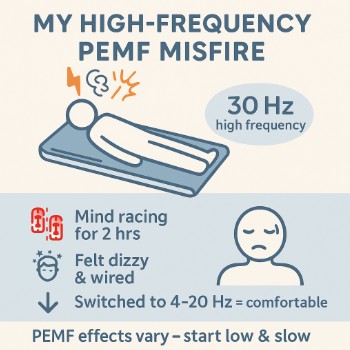
The closest thing I could compare it to was how I would feel during an engineering final exam in university, I used to work myself up quite a bit during those exams to try and perform; in some instances I would even be thinking so furiously that I would figure out things that I never understood during class or homework up till that point.
It took a couple hours for my mind to slow down and relax back to normal, and I while I was getting a lot of work done with my mind running so fast it was not a comfortable experience at all, I really didn’t like it.
So that all said, if I use PEMF at a lower frequency, I never have a problem and I do make sure to use it at a very low frequency like 4 Hz if I’m using it before or close to bedtime and now if I’m using it in the morning I’ll usually keep it around 20 Hz.
You can see what PEMF mat I use at home now as well as a list of benefits rather than side effects that you can get from PEMF on the page I wrote on the benefits of PEMF mats.
Who should not use PEMF
Every PEMF manufacturer has their own list of contraindications as to who should not use PEMF therapy, so here I’ve gone and compiled across all the brands that I could a “master” list of contraindications:
- Individuals with pacemakers/defibrillators
- Individuals with active medical implants (medication pumps) are absolute contraindication
- Epilepsy: safety of PEMF has not been established
- Deep Vein Thrombosis (DVT)
- Those in immunosuppressive therapy due to transplantation
- Pregnancy (no evidence of harm but following a precautionary approach)
With any condition, not limited to those above, you should consult your own doctor prior to the use of PEMF therapy.
There are also warnings for a few other conditions:
- During fever
- Infectious disease
- Cardiac rhythm disorder
- Psychoses
- Tumor diseases or other serious diseases requiring ongoing treatment require discussion with your own doctor
These are only guidelines from the various manufacturers of PEMF devices and mats, any concern you have you should discuss with your own doctor.
I’ll state here that you shouldn’t take anything you’ve read on this website as medical advice, always consult your own doctor with any concerns you may have – here at Health Mat Review we are content creators only and do not provide any medical advice, for more information have a read over our medical disclaimer page.
ICNIRP Guidelines for Electromagnetic Field Exposure
Who would have thought, but yes, there actually is an international organization which sets guidelines on what’s considered safe exposure to electro-magnetic fields in both the workplace and for the general public.
This is the ICNIRP, the International Commission on Non-Ionizing Radiation Protection, they were formed in 1992 to make safety guidelines for EMF exposure as electronic devices were becoming so common worldwide.
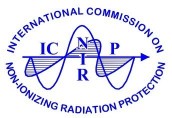
Non-ionizing simply means electromagnetic fields/radiation with frequencies too low to ionize atoms or molecules, this means they don’t carry enough energy to heat up body tissues. Both everyday household electronics and PEMF therapy fall into this category.
So although it doesn’t sound like the ICNIRP has much to do with PEMF, in fact their guidelines are considering the exactly the same thing, repeating or pulsing, electro-magnetic fields just like PEMF therapy.
We looked specifically at their publication on low frequencies like those used in PEMF, ICNIRP GUIDELINES FOR LIMITING EXPOSURE TO TIME‐VARYING ELECTRIC AND MAGNETIC FIELDS (1HZ – 100 kHZ).
From this publication we excerpted the following chart from page 12 and marked it up in red and green to make it easier to read.
On this chart the ICNIRP shows the range of intensity and frequency they consider safe, and the upper range which is considered hazardous for extended exposure.
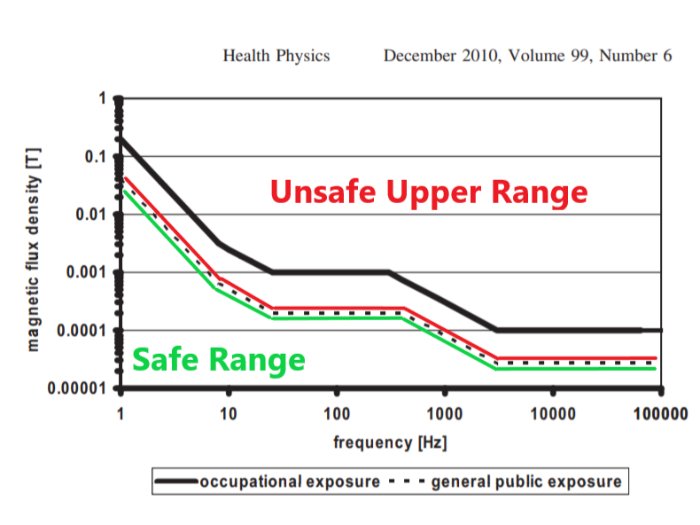
I thought this was such a cool chart that I wanted to see where the operating ranges of PEMF devices would be if we drew them on top, above or below the safe range line.
I did a drawing just like this for each device on our PEMF Mats page and it’s very cool to see the differences and where each device is operating, check it out in the PEMF Mats Safety section on that page.
Again, the chart from the ICNIRP is showing the zones where they consider extended exposure to be hazardous, so for a session of PEMF therapy, it is somewhat up to interpretation as to what would be considered “extended” exposure.
At the end of the day the magnetic field strength and frequency are determining how much energy is being carried by the field (and subsequently delivered when using PEMF therapy).
Now let’s look more in detail about what this chart shows us when it comes to high intensity PEMF.
Is High Intensity PEMF Safe?
High intensity PEMF hasn’t been proven as safe, or as dangerous, however if we consider the guidelines chart from the ICNIRP, then as we will see below there are certain ranges to be avoided.
The left hand axis of the chart shows intensity, or “magnetic flux density” in [T], Tesla, this is just a conversion from intensity in Gauss, like a mile to a kilometer.
Along the bottom of the chart shows the frequency in Hertz, [Hz].
All we need to do is check where an intensity level is, and see how high (how far right) the frequency can be before it crosses over the line into the hazardous upper range.
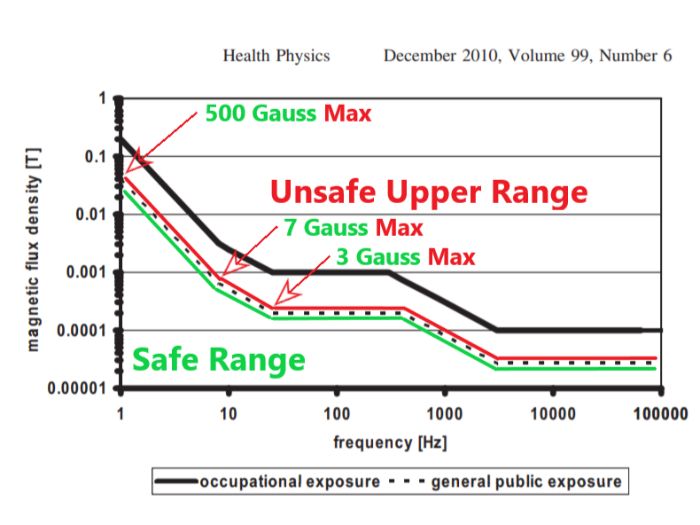
I marked a few intensity levels for easier viewing, 500 Gauss, 7 Gauss, and 3 Gauss.
The line shows us the following maximum levels of frequency for these levels of intensity,
- 500 Gauss = 0.05 Tesla > 1 Hz max frequency
- 7 Gauss = 0.0007 Tesla > 10 Hz max frequency
- 3 Gauss = 0.0003 Tesla > from 40 Hz to 800 Hz max frequency
This means, at least according to the ICNIRP guidelines, that for a high intensity PEMF of 500 Gauss, the max frequency can only be 1 Hz and no more.
We saw from the 335 PEMF studies in our database, on our Does PEMF really work page in the Results per Intensity section, that there is a huge number of positive results even in just the 0 to 1 Gauss very low intensity category, this is why personally I use a low intensity PEMF which stays well within the safe range of the ICNIRP chart.
Are EMFs Dangerous, isn’t PEMF Therapy EMFs?
You may have heard of EMF’s and that it is good to avoid them, or that they are harmful.
EMF’s are the electromagnetic fields emitted by all of our everyday electronics as well as power lines and even cell towers.
These electromagnetic fields differ from PEMF in that they are typically extremely high frequency and highly erratic as they transfer data, and in modern life we are exposed to them constantly, all day and all night.

PEMF therapy with its dramatically lower frequency (closer to Earth’s resonance frequency at 7.8 Hz) and uniform intensity, can restore a cell’s voltage gradient instead of disrupting it as shown in the research.
Unnatural EMF’s have raised some concerns of the possibility they disrupt the natural biology of our bodies or damage the DNA of our cells, however the current consensus around EMFs is that they aren’t overwhelmingly harmful or dangerous.
- National Cancer Institute
- WHO
- Cancer.Org
- Radiation Safety Canada
It would also likely be true to say that it would be wise to limit our exposure to EMFs in our everyday lives if we can, there are even products to help with this you can read about on our EMF Protection page.
Practical PEMF Safety Tips
Here’s a short list you can keep in mind when you go try out or use PEMF at home to try and make sure you have the best experience and don’t experience any discomfort like I did.
- Follow the device/mat’s intensity, frequency and session-time guidelines
- Start with shorter sessions (10-15 minutes) to gauge your personal tolerance
- Start with lower frequency and lower intensity to gauge your personal tolerance
- Keep the PEMF applicator/coils as far as you can from any implants during usage (and follow your doctor’s instructions and the device’s instructions to whether you should use PEMF at all with your implant of any kind)
- Stay hydrated and allow yourself time for a brief rest after treatment if you feel off or woozy
- Report any persistent discomforts to your clinician or device supplier
If you follow these steps and keep them in mind you should find yourself enjoying only the benefits of PEMF.
How you can “try before you buy”
A brief final note here about how you can try PEMF risk free before making any purchase if you are concerned about potential side effects for yourself.
I have a couple recommendations for this:
- Buy a PEMF mat with an extended (up to 3 month) 100% money back guarantee to try it at home or,
- Check our PEMF near me directory to find a local (unaffiliated with Health Mat Review) location
You can check our best pemf mats page in the return policy section to see which mats offer the best risk free trial periods here:
The PEMF directory I built to try and help people find PEMF in their area, that is, clinicians and various practitioners who use or provide PEMF in their office so that you can go and pay for a session – and not a whole device, and you can check that out here:

Frequently Asked Questions
Who should avoid PEMF Therapy?
People with pacemakers, defibrillators, medication pumps or other active implants, plus those who are pregnant, epileptic, have deep‑vein thrombosis or are on post‑transplant immunosuppressants, should not use PEMF unless cleared by their physician. Other cautions include fever, infectious disease, severe heart‑rhythm disorders, active tumors or serious psychiatric conditions. Always review the device’s contraindications and consult your doctor before starting treatment.
What side-effects can occur and how do I minimize them?
PEMF is non‑ionizing, so tissue heating isn’t an issue, but brief warmth, tingling, light‑headedness, mild nausea, fatigue or a “wired” feeling can appear and usually fade within minutes to a couple of hours. Begin with short (10‑15 min) sessions at low intensity (< 10 Gauss) and low frequency (< 20 Hz), stay hydrated, and rest if you feel off. Report any persistent discomfort to your clinician or device supplier.
What field strengths, frequencies, and session lengths are considered safe?
ICNIRP guidelines show that low‑frequency, low‑intensity PEMF (e.g., 0-10 Gauss up to ~40 Hz) lies well inside the recommended safe exposure zone, while very high intensities (e.g., 500 Gauss) should be limited to about 1 Hz. Start with gentle settings – a few Gauss at single‑digit Hertz – for 10-20 minutes and increase only if well tolerated. Staying within these ranges keeps you comfortably below the “hazard” line for extended exposure.
If you found this interesting you can check these out next
You can find links to all our other pages on PEMF including the answers and results we got from doing a macro-analysis of 335 PEMF research studies on our PEMF therapy page.
The latest and most popular PEMF mats compared side by side on our best PEMF mats page, or even go filter and search through the 335 PEMF studies in our database on our PEMF study explorer page that gives you special search and filter functions which don’t exist on the Pubmed website.




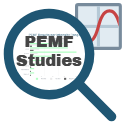


Comments are moderated. Tick “Email me when my question is replied to” to get notified.